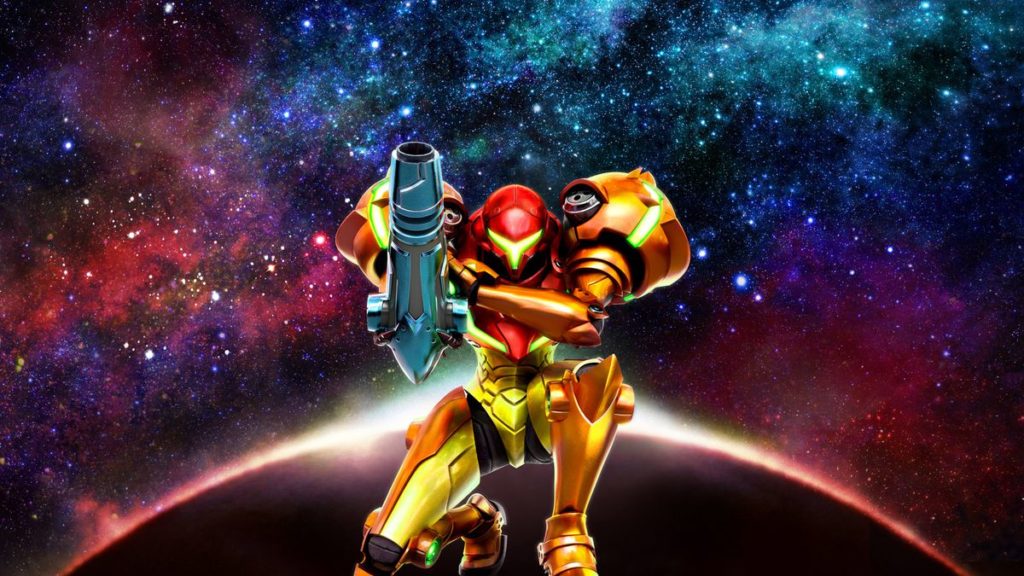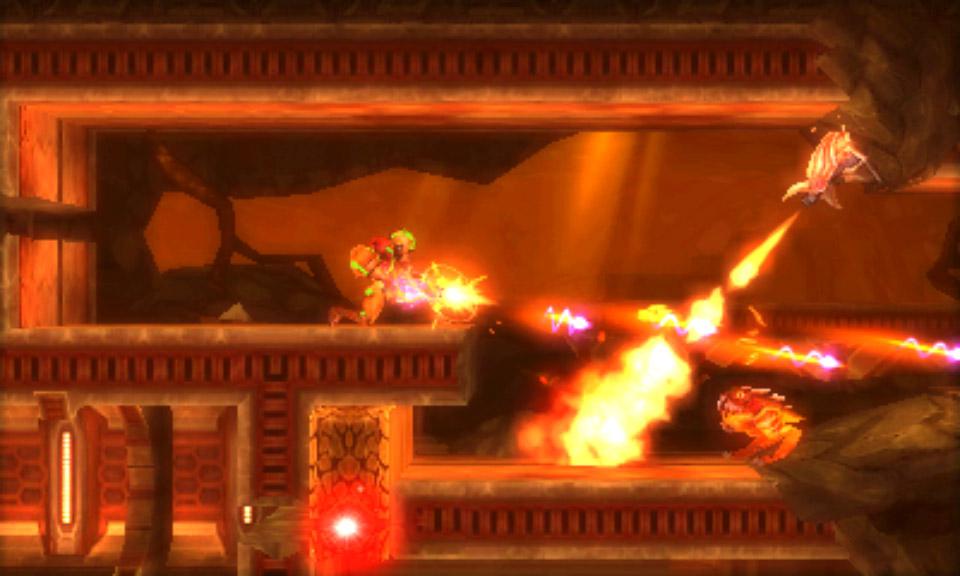Samus Returns is a game that wants to be something, but can’t. After all, it is a remake of an existing game, Metroid 2: Return of Samus. On top of that, not only is the original game a beloved classic, but it’s also very old, and runs on a piece of hardware that was outdated even when it was brand new.

All of these factors work to dictate what a game like Samus Returns can and cannot do. By the rules of Modern Videogame Design, the following elements of 1991’s Return of Samus are unacceptable:
- Its stark, mostly-black backgrounds.
- It’s creepy chiptune music, despite the fact that it helps to create a certain mood that is absolutely perfect for the game’s setting.
- The fact that the planet is mysteriously drained of deadly acid as you kill Metroids.
- The relative lack of upgrades compared to other, more advanced Metroid games.
- The general lack of story elements.
All of these things get “fixed” by Samus Returns, and the result is an experience that feels all too predictable:
- The backgrounds are now filled with stuff: ancient ruins, (still working) mining equipment, robotic defense systems. It’s no longer the hostile and extremely alien world of the original game. Instead, it’s just another place where the Chozo once set up shop.
- The remixed songs strip away any of the subtlety and texture of the original tracks, opting instead for a wall of sound that is as generically epic as any other bad video game soundtrack. Also, they added songs from other Metroid games, which are the very definition of soundtrack filler. But hey, at least you remember them right? Nerds love being stroked by callbacks!
- There are now Chozo altars you have to visit once you’ve defeated a certain number of Metroids, which then drain the acid once activated. So now we have an in-game explanation for something that needed no in-game explanation.
- There are now so many different weapons and abilities that you have to use the touchscreen to toggle some of them, because there aren’t enough buttons. This can be very frustrating when you’re in the heat of battle, and forget to, say, switch off your Ice Beam.

In these ways, Samus Returns is exactly the kind of modern remake one would expect. It fills itself up with things not because they’re good, but because people expect not only for there to be certain features, but also a certain amount of them. This isn’t Art, but Content.
However, every so often the game manages to demonstrate a bit of personality.
For instance, Samus Returns is surprisingly challenging. Even considering the fact that it can (if you want it to) point out the location of every Metroid you need to hunt down, this clue is usually less helpful than you’d think. Oftentimes the target Metroid is in an area of the map you haven’t yet reached – and the way to get there may not be obvious. At best it may confirm that you’re going in the right direction (but then again, maybe not).
Similarly, many of the game’s once-hidden upgrades are explicitly listed on the map, but getting to some of them can, at times, require puzzle solving. It feels like a cheeky, if not full-on trolling response to Nintendo’s insistence on giving the player a helping hand. You can see it, but can you get to it?
Then there are instances in which the game asks you to do the kind of fancy maneuvers that are normally only required for crazy speedruns and sequence breaks. One example involves the following:
- Freezing an enemy with the Ice Beam to use it as a platform (just make sure it isn’t too high or too low) then
- Quickly jumping on top of it, before quickly jumping back off (because Samus can only stand on it for a split second before she slips off) and
- While middair, switching to your missiles and firing one at one of the four destructible blocks above you then
- Grabbing on to the ledge you just created with the missile, and climbing up into the tunnel above you.

This is assuming that you actually created a ledge, and didn’t just blow up all the blocks with your missiles. It also assumes that you jumped high enough to reach the ledge, and that you didn’t jump too far wide right or left to grab onto it.
There are moments like these where Samus Returns downright expects you to be a veteran Metroid player, who understands the crazy things that Samus’ moveset enables, and knows how to pull it all off.
There were times where I welcomed this level of challenge, and other times where it grated, but at the very least it gives the game some character.
As do the handful of times where it feels free to be something other than a recreation of Return of Samus. One of my favorite moments is one in which you accidentally activate a giant mining robot. This leads to a long chase sequence, in which you have to jump around obstacles so that it doesn’t crush you to death. By the time the sequence is over, you find yourself far away from where you started, unsure as to how long it might take to get back, or what dangers might get in your way. It’s one of the few times that Samus Returns recreates the feeling of isolation and fear that was endemic in the original game.
I don’t recommend you play Samus Returns. All the little hints of quality are overwhelmed by the sheer tedium of its basic structure. Better to save yourself some time and money and play Return of Samus. At least that has a unique point of view.

Additional Thoughts
This section has what some may construe as spoilers. So don’t read it if that bothers you!
- Some of the background art gets better later on in the game (the underwater sections in particular are quite pretty). As the 3DS got older, more and more games gave up on the 3D gimmick, but Samus Returns eventually becomes a final showcase for the tech.
- It didn’t dawn on me until later, but the game is surprisingly linear. If you ever get stuck, the area you are currently in is almost certainly where your next destination is located. Backtracking is only necessary if you want to go back and acquire hidden powerups. This largely runs contrary to the design of most Metroid games, so judge it as you see fit.
- There are some powerups that you can only find by using the Super Bomb to catapult Samus (in her Morph Ball form) across the room. While bomb jumping is a time honored technique, I’m not sure if any other game in the series supports Super Bomb Jumping. If not, then I think it’s a bit unfair to introduce it without warning into Samus Returns.
- In the original Return of Samus, the game ends with Samus discovering the Baby Metroid, which then follows her as she escapes the planet. In Samus Returns, the game doesn’t quite end here. You can travel across the entire map with the baby in tow, and it will open up areas that were once blocked off. I can’t tell if this was an attempt at trolling, but it kind of feels like it is. Quite a few Missile Expansions are locked away in this fashion, despite the fact that the only thing left to do is face the final boss. Furthermore, these sections are blocked off by colored, crystalline formations (which the Metroid eats). These crystals are something that’s never been seen before in a Metroid game, and it’s not entirely obvious what, if anything, will clear them away. If you’re the kind of person who likes to experiment with new weapons, you may find yourself trekking to a patch of crystals every time you get a new upgrade, in hopes that that will do the trick. If so, you will be sorely disappointed (and will have wasted a lot of time).
- Speaking of the final boss, it’s Ridley. Again. Why every game feels the need to drag that old bag of bones out is beyond me. Just kidding, I know exactly why – the very lifeblood of fanboys is made out of references and callbacks.

